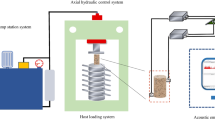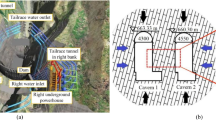Abstract
The experimental data shows that most rocks behave nonlinearly in nature. The modified nonlinear Hoek–Brown failure criterion was considered to investigate the bearing capacity problem of shallow rigid foundations on rock masses subjected to horizontal seepage forces. Two multi-wedge translational failure mechanisms, including symmetrical and non-symmetrical mechanisms were used in the closed-form of the upper bound method of the limit analysis theory. The symmetrical failure mechanism was used in the case of no seepage, while the seepage effect was considered in the non-symmetrical mechanism. The variation of seepage forces was obtained as a function of gradient ratio i(γw/γsub) in the developed formulation. The bearing capacity coefficients Nγ, Nq and Nσ are introduced for the case of seepage flow condition. The results show that the magnitude of the bearing capacity coefficients reduces continuously with an increase in the value of gradient ratio i(γw/γsub). The obtained results were compared and offered for functional use in foundation engineering.
















Similar content being viewed by others

Abbreviations
- B 0 :
-
Width of footing
- c :
-
Cohesion
- σ ci :
-
Uniaxial compressive strength of the intact rock
- σ n :
-
Normal stress
- σ′ 3max :
-
Upper limit of confining stress
- σ′1 and σ′3 :
-
Major and minor effective stresses at failure, respectively
- m b :
-
Value of the Hoek–Brown constant m for the rock mass
- m i :
-
Value of m for the intact rock
- s and a :
-
Constants which depend upon the characteristics of the rock mass
- τ :
-
Shear stress
- GSI:
-
Geological strength index of rock mass
- D :
-
Disturbance coefficient
- di and li :
-
Discontinuity lines
- i(γw/γsub):
-
Gradient ratio
- Nσ, Nq and Nγ :
-
Bearing capacity factors of dry rock mass
- \(N_{\sigma }^{S} , \;N_{q}^{S}\) and \(N_{\gamma }^{S}\) :
-
Bearing capacity factors in the presence of water seepage
- N σ0 :
-
Bearing capacity factor for weightless rock
- k :
-
Number of rigid blocks in failure mechanism
- q uD :
-
Ultimate bearing capacity of the dry rock mass
- q uS :
-
Ultimate bearing capacity of the rock mass subjected to seepage
- S i :
-
Area of block i
- V 0 :
-
Initial downward velocity of footing for M1 mechanism
- V i :
-
Velocities of the blocks i = 1,…, k
- γ :
-
Unit weight of rock
- ΔV :
-
Velocity along each velocity discontinuity
- θ, αi and βi :
-
Angular parameters of failure mechanisms
- ϕ t :
-
Tangential friction angle
- c′ :
-
The equivalent Mohr–Coulomb cohesion of the rock mass
- ϕ′ :
-
The equivalent Mohr–Coulomb friction angle of the rock mass
References
Hansen D, Roshanfekr A (2012) Assessment of potential for seepage-induced unraveling failure of flow-through rockfill dams. Int J Geomech 12:560–573. https://doi.org/10.1061/(ASCE)GM.1943-5622.0000145
Hoek E, Brown ET (1980) Empirical strength criterion for rock masses. J Geotech Eng Div ASCE 106:1013–1035
Hoek E, Carranza C, Corkum B (2002) Hoek–Brown failure criterion, 2002 edition. Narms-Tac, pp 267–273. https://doi.org/10.1016/0148-9062(74)91782-3
Imani M, Fahimifar A, Sharifzadeh M (2012) Upper bound solution for the bearing capacity of submerged jointed rock foundations. Rock Mech Rock Eng 45:639–646. https://doi.org/10.1007/s00603-011-0215-9
Javid A, Fahimifar A, Imani M (2015) Numerical investigation on the bearing capacity of two interfering strip footings resting on a rock mass. Comput Geotech 69:514–528. https://doi.org/10.1016/j.compgeo.2015.06.005
Kumar J, Chakraborty D (2014) Bearing capacity of foundations with inclined groundwater seepage. Int J Geomech 13:611–624. https://doi.org/10.1061/(ASCE)GM.1943-5622.0000241
Mansouri M, Imani M, Fahimifar A (2019) Ultimate bearing capacity of rock masses under square and rectangular footings. Comput Geotech 111:1–9. https://doi.org/10.1016/j.compgeo.2019.03.002
Mao N, Al-Bittar T, Soubra A-H (2012) Probabilistic analysis and design of strip foundations resting on rocks obeying Hoek–Brown failure criterion. Int J Rock Mech Min Sci 49:45–58. https://doi.org/10.1016/j.ijrmms.2011.11.005
Merifield RS, Lyamin AV, Sloan SW (2006) Limit analysis solutions for the bearing capacity of rock masses using the generalised Hoek–Brown criterion. Int J Rock Mech Min Sci 43:920–937. https://doi.org/10.1016/j.ijrmms.2006.02.001
Michalowski RL (1997) An estimate of the influence of soil weight on bearing capacity using limit analysis. Soils Found 37:57–64
Saada Z, Maghous S, Garnier D (2008) Bearing capacity of shallow foundations on rocks obeying a modified Hoek–Brown failure criterion. Comput Geotech 35:144–154. https://doi.org/10.1016/j.compgeo.2007.06.003
Saada Z, Maghous S, Garnier D (2011) Seismic bearing capacity of shallow foundations near rock slopes using the generalized Hoek–Brown criterion. Int J Numer Anal Methods Geomech 35:724–748. https://doi.org/10.1002/nag.929
Serrano A, Olalla C, Gonzalez J (2000) Ultimate bearing capacity of rock masses based on the modified Hoek–Brown criterion. Int J Rock Mech Min Sci 37:1013–1018
Soubra A-H (1999) Upper-bound solutions for bearing capacity of foundations. J Geotech Geoenviron Eng 125:59–68. https://doi.org/10.1061/(ASCE)1090-0241(1999)125:1(59)
Terzaghi K (1943) Theoretical soil mechanics. Wiley, Hoboken
Veiskarami M, Habibagahi G (2013) Foundations bearing capacity subjected to seepage by the kinematic approach of the limit analysis. Front Struct Civ Eng 7:446–455. https://doi.org/10.1007/s11709-013-0227-5
Veiskarami M, Kumar J (2012) Bearing capacity of foundations subjected to groundwater flow. Geomech Geoeng 1:1. https://doi.org/10.1080/17486025.2011.631038
Yang X-L (2009) Seismic bearing capacity of a strip footing on rock slopes. Can Geotech J 46:943–954. https://doi.org/10.1139/T09-038
Yang XL, Yin JH (2005) Upper bound solution for ultimate bearing capacity with a modified Hoek–Brown failure criterion. Int J Rock Mech Min Sci 42:550–560. https://doi.org/10.1016/j.ijrmms.2005.03.002
Author information
Authors and Affiliations
Corresponding author
Additional information
Publisher's Note
Springer Nature remains neutral with regard to jurisdictional claims in published maps and institutional affiliations.
Appendices
Appendix 1: M1 Mechanism (Dry Rock Masses)
1.1 Geometry
For the triangular block i, the lengths li and di and the area Si are given as follows:
1.2 Internal Energy Dissipation
1. Along BC:
where
2. Along lines di (i = 1, …, k):
where
3. Along lines li (i = 2, …, k):
where
Because of the symmetry of the M1 mechanism, the total energy dissipation in the whole mechanism is twice the summation of these three parts, i.e., Eqs. (24), (28), and (30):
1.3 External Work
1. External work due to the surcharge loading:
2. External work due to self-weight of the central triangular wedge, ABC:
where
3. External work due to self-weights of the remaining 2k triangular wedges:
where
4. External work due to the footing load:
The total external work is the summation of the four contributions, i.e., Eqs. (33), (35), (37), and (39):
Appendix 2: M2 Mechanism (Rock Masses Subjected to Seepage)
2.1 Geometry
For the triangular block i, the lengths li and di, and the area Si are given as follows:
2.2 Internal Energy Dissipation
1. Along lines di (i = 1, …, k):
where
2. Along lines li (i = 1, …, k − 1):
where
The total energy dissipation in the whole mechanism is equal to the summation of these two parts, i.e., Eqs. (44) and (46):
2.3 External Work
1. External work due to self-weights and seepage forces of the rock mass in motion of the k triangular rigid blocks:
where
2. External work due to the surcharge loading and the corresponding seepage forces:
where
3. External work due to the footing load and the corresponding seepage forces:
The total external work is the summation of the three contributions, Eqs. (49), (52), (55):
Rights and permissions
About this article
Cite this article
AlKhafaji, H., Imani, M. & Fahimifar, A. Ultimate Bearing Capacity of Rock Mass Foundations Subjected to Seepage Forces Using Modified Hoek–Brown Criterion. Rock Mech Rock Eng 53, 251–268 (2020). https://doi.org/10.1007/s00603-019-01905-6
Received:
Accepted:
Published:
Issue Date:
DOI: https://doi.org/10.1007/s00603-019-01905-6



